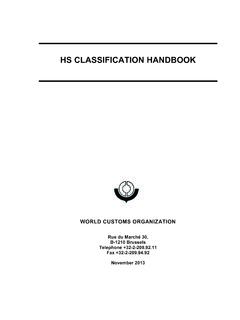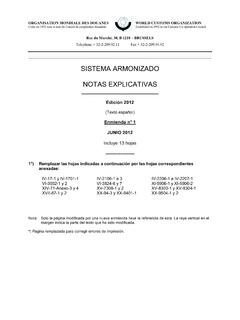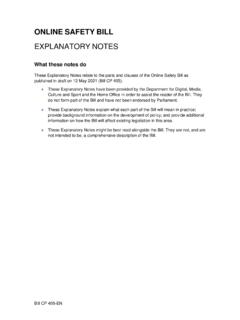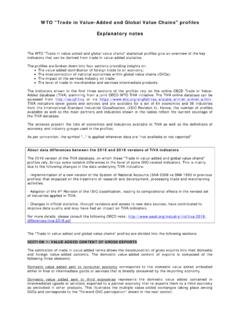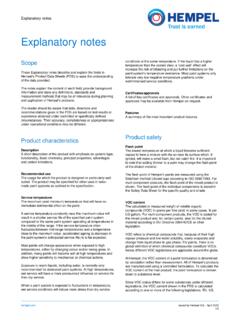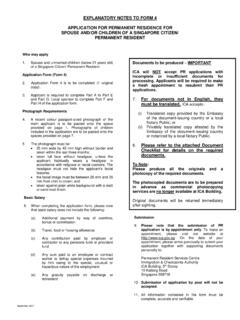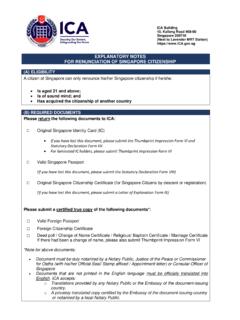Transcription of HARMONIZED SYSTEM EXPLANATORY NOTES
1 ORGANISATION MONDIALE DES DOUANES Cr e en 1952 sous le nom de Conseil de coop ration douani re WORLD CUSTOMS ORGANIZATION Established in 1952 as the Customs Co-operation Council Rue du March , 30, B 1210 BRUSSELS Telephone + Fax + _____ HARMONIZED SYSTEM EXPLANATORY NOTES _____ 2012 Edition (English text) Amending Supplement n 2 DECEMBER 2012 (17 sheets) ------------------- 1 ) Remove the following sheets and substitute those annexed : IV-1603-1 to IV-1605-1 * IV-1901-1 to IV-1902-1 * VI-3507-3 and 4 VII-40-5 and VII-4001-1 XI-5906-1 and 2 XVI-8415-2 and 3 XVI-8435-1 and 2 XVI-8438-1 and 2 XVI-8473-1 and 2 XVI-8509-2 and 3 XVII-87-1 and 2 XVII-8703-1 to XVII-8704-3 XVII-8711-1 and XVII-8712-1 Note : Only the page modified by a new Amending Supplement has a reference to this Amending Supplement.
2 A vertical line in the margin indicates where the text has been modified. * : The replacement of this sheet was necessitated by printing errors. IV-1603-1 - Extracts and juices of meat, fish or crustaceans, molluscs or other aquatic invertebrates. Though obtained from different sources, the extracts of this heading have very similar physical characteristics (appearance, odour, flavour, etc.) and chemical composition. The heading includes : (1) Meat extracts. These are concentrates generally obtained by boiling or steaming meat under pressure and concentrating the resultant liquid after removal of the fat by filtration or centrifuging.
3 These extracts may be solid or liquid according to the degree of concentration. (2) Meat juices obtained by pressing raw meat. (3) Extracts of fish or of crustaceans, molluscs or other aquatic invertebrates. Extracts of fish are obtained, , by concentrating water extracts of the flesh of herring or other fish or made from fish meal (whether or not defatted); during the production all or part of the constituents which give the fishy taste ( , trimethylamine in the case of sea fish) may be eliminated and such extracts therefore have characteristics similar to those of meat extracts.
4 (4) Juices obtained by pressing raw fish or crustaceans, molluscs or other aquatic invertebrates. All these products may contain salt or other substances added in sufficient quantities to ensure their preservation. Extracts are used for making certain food preparations such as soups (whether or not concentrated) and sauces. Juices are used mainly as dietetic foods. The heading does not cover : (a) Soups and broths and preparations therefor and homogenised composite food preparations containing meat, fish, etc.
5 , extract (including soups and broths in the form of tablets or cubes) which in addition to such products contain other substances such as fat, gelatin and usually a large proportion of salt (heading ). (b) Fish or marine mammal solubles of heading (c) Medicaments in which any products of this heading serve merely as a support or vehicle for medicinal substances (Chapter 30). (d) Peptones and peptonates (heading ). IV-1604-1 - Prepared or preserved fish; caviar and caviar substitutes prepared from fish eggs.
6 - Fish, whole or in pieces, but not minced : - - Salmon - - Herrings - - Sardines, sardinella and brisling or sprats - - Tunas, skipjack and bonito (Sarda spp.) - - Mackerel - - Anchovies - - Eels - - Other - Other prepared or preserved fish - Caviar and caviar substitutes : - - Caviar - - Caviar substitutes This heading covers : (1) Fish which has been boiled, steamed, grilled, fried, roasted or otherwise cooked; it should be noted, however, that smoked fish which has been cooked before or during smoking remains classified in heading provided it has not been prepared in any other way.
7 (2) Fish prepared or preserved in vinegar, oil, etc.; fish marinades (fish prepared in wine, vinegar, etc., with added spices or other ingredients); fish sausages; fish paste; the products known as anchovy paste and salmon paste (pastes made from these fish with added fat), etc. (3) Fish, and their parts, prepared or preserved by other processes not provided for in headings to , , fish fillets merely covered with batter or bread crumbs, prepared milt and livers, finely homogenised fish (see the General EXPLANATORY Note to this Chapter, Item (4)) and pasteurised or sterilised fish.
8 (4) Certain food preparations (including so-called prepared meals ) containing fish (see the General EXPLANATORY Note to this Chapter). (5) Caviar. This is prepared from the roe of the sturgeon, a fish found in the rivers of several regions (Italy, Alaska, Turkey, Iran and Russia); the main varieties are Beluga, Schirp, Ossiotr and Sewruge. Caviar is usually in the form of a soft, granular mass, composed of eggs between 2 and 4 mm in diameter and ranging in colour from silver-grey to greenish-black; it has a strong smell and a slightly salty taste.
9 It may also be presented pressed - , reduced to a homogeneous paste, sometimes shaped into small slender cylinders or packed in small containers. IV-1604-2 (6) Caviar substitutes. These are products consumed as caviar but prepared from the eggs of fish other than sturgeon ( , salmon, carp, pike, tuna, mullet, cod, lumpfish), which have been washed, cleaned of adherent organs, salted and sometimes pressed or dried. Such fish eggs may also be seasoned and coloured. All these products remain classified in the heading whether or not put up in airtight containers.
10 This heading also excludes : (a) Fish roes, , fish eggs still enclosed in the ovarian membrane, prepared or preserved only by processes provided for in Chapter 3 (Chapter 3). (b) Fish extracts and juices (heading ). (c) Pasta stuffed with fish (heading ). (d) Sauces and preparations therefor, mixed condiments and mixed seasonings (heading ). (e) Soups and broths and preparations therefor and homogenised composite food preparations (heading ). IV-1605-1 - Crustaceans, molluscs and other aquatic invertebrates, prepared or preserved.

